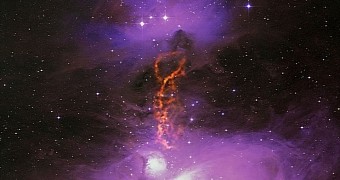Researchers with the National Radio Astronomy Observatory in the US believe to have found evidence that freakishly large dust grains are lurking in the proximity of the Orion Nebula.
These space pebbles are said to be hiding in filaments of star-forming gas, and are estimated to be about 100 to 1,000 times larger than the dust grains astronomers are used to observing in the proximity of protostars.
The region where these space pebbles are believed to be hiding is dubbed OMC-2/3. It is part and parcel of the Orion Molecular Cloud Complex, and was studied with the help of the Green Bank Telescope.
The OMC-2/3 region is about 10 light-years old, and scientists suspect that, over the course of the following 100,000 to 1 million years, it will turn into a newly born star cluster. This is because dense knots in its midst are showing signs of becoming stars.
If the National Radio Astronomy Observatory specialists are right and this region does indeed pack freakishly oversized dust grains, this would mean that it is possible for stars to form in environments very similar to the ones that birth planets.
“The large dust grains seen by the GBT would suggest that at least some protostars may arise in a more nurturing environment for planets,” explains astronomer Scott Schnee.
“Rather than typical interstellar dust, these researchers appear to have detected vast streamers of gravel – essentially a long and winding road in space,” adds specialist Jay Lockman, who was not involved in this study.
Should the existence of these space pebbles be confirmed by future investigations, the oversized dust grains have high chances to be classified as a new type of interstellar particles.

 14 DAY TRIAL //
14 DAY TRIAL //